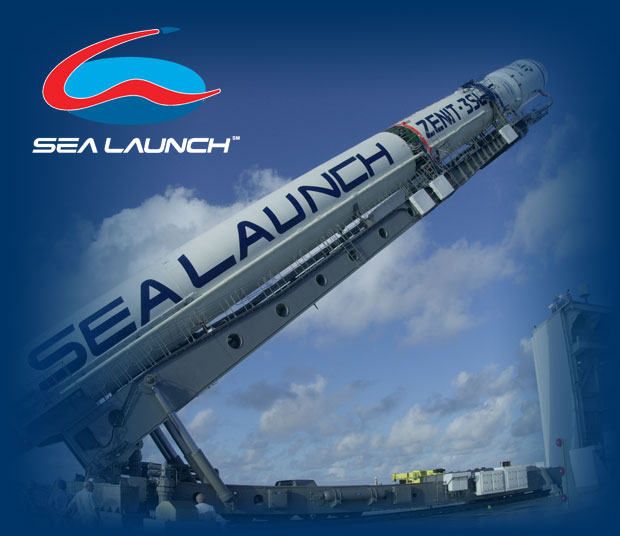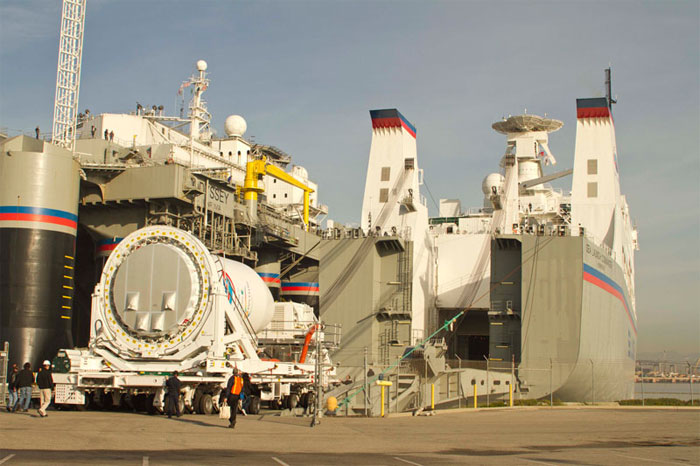.
23.01-2013

The Sea Launch vessels have departed Sea Launch Home Port in Long Beach, Calif., for the equator, in preparation for the launch of the Intelsat 27 satellite. Liftoff is scheduled for 22:56 Pacific Standard Time on January 30, 2013 (06:56 UTC, on January 31st) at the opening of the 58-minute launch window.
Upon their arrival at the launch site at 154 degrees West longitude, the Sea Launch team will initiate a 72-hour countdown. After ballasting the launch platform Odyssey to launch depth, the team will roll out and erect a Zenit-3SL rocket on the launch pad, execute final tests and proceed with fueling operations and launch. Prior to fueling, all personnel on the launch platform will transfer to the Sea Launch Commander for the duration of the mission. The team monitors both marine and launch operations remotely from the ship, positioned about four miles up range of the platform.
On launch day, the Zenit-3SL vehicle will lift the 6,215-kilogram (13,702 lbs.) Intelsat 27 spacecraft into geosynchronous transfer orbit. Based on the Boeing 702MP platform, Intelsat 27 is designed to provide 15 or more years of satellite service. The satellite will support customers in North America, South America, the Atlantic Ocean region and Europe, and will host a UHF communications payload for use in military applications. The launch will mark Intelsat's completion of the world's first global broadband mobility platform, which will provide uninterrupted connectivity to customers at sea, on land and in the air.
Intelsat 27 will be located at the 304.5 degrees East orbital position currently occupied by Intelsat 805 and Galaxy 11.
-

The Intelsat 27 satellite will be located at 304.5°East longitude and will replace the IS-805 satellite. Intelsat 27 will provide increased and enhanced capacity for media, network and government services. Based upon the BSSI 702-MP platform, Intelsat 27 will carry 20 C-band transponders, 20 Ku-band transponders and 20 UHF transponders, weighing approximately 6,203 kilograms (13,675 lbs.) at launch.
Lift-off will occur at 22:56 Pacific Standard Time on January 30, 2013 (06:56 UTC, on January 31st) at the opening of the 58 minute launch window.
-

PLU Rollout on January 9th
-

ILV Transfer to LP on January 12th
-

ILV Transfer to LP on January 12th
-

ILV Rollout on January 13th
-

ILV Rollout on January 13th
-
Quelle: Sea Launch
-
Update: 1.02.1013 Fehlstart von Zenith-3SL-Rakete
-
An accident occurred in the launch of the rocket Zenith-3SL with the satellite Intelsat-27 from a floating platform in the Pacific. The communication contact with the rocket is lost, the telemetric data is not coming.
“The engine failed in the rocket,” a source in the Russian aerospace industry.
The source reported that Zenith-3SL fell down not far from the floating platform Odyssey, from which the rocket was launched. Other details are unclear yet.-
-
A Zenit-3SL rocket carrying an Intelsat-27 (IS-27) telecoms satellite crashed into the Pacific Ocean shortly after launch on Friday, following an emergency shutdown of its first stage motor, Russian space corporation RKK Energia head Vitaly Lopota said.
"There was a malfunction - an emergency shutdown of the first-stage motor - around 50 seconds into the flight. We're now discussing what happened," he said.
The Sea Launch consortium, led by Energia, launched the Zenit rocket from its floating platform Odyssey at an equatorial launch site in international waters in the Pacific Ocean at 10.56 a.m. Moscow time (6.55 GMT).
The rocket fell into the sea not far from the Odyssey, which was not damaged in the failed launch, a Russian space industry source told RIA Novosti.
The Zenit-3SL integrated launch vehicle is a liquid-propellant rocket consisting of three stages and a payload unit.
The first stage is powered by the RD-171M engine designed by Russia’s NPO Energomash rocket engine design bureau.
The RD-171M is one of the most powerful rocket engines in the world, producing 740,000 kilograms of thrust at liftoff.
Sea Launch AG was formed in 1995 as a consortium of four companies from Norway, Russia, Ukraine and the United States, and managed by US aerospace giant Boeing.
The project aimed to use a floating launch site to place rockets on the equator, the best possible location for launch, which gives the rocket additional speed on lift-off thanks to centripetal force caused by the earth's rotation. That in turn means higher possible payloads for a given power of the launcher.
Sea Launch resumed operations in 2011 after a 30-month hiatus that saw passage through US Chapter 11 bankruptcy, a change of ownership from Boeing to Energia, and a move of the company headquarters from California to Switzerland.
Of the 34 previous Sea Launch rocket launches since 1999, two have failed, with a third placing its payload into an incorrect, but recoverable orbit.
The first failure occurred on March 12, 2000, when a software error resulted in premature cut-off of the second stage, leaving its ICO F-1 satellite unable to reach orbit.
On June 29, 2004, during the launch of an Apstar 5 satellite, the upper stage shut down 54 seconds early due to a wiring fault, leaving the satellite in a lower than planned orbit.
A Zenit-3SL exploded on the launch pad on 30 January, 2007, after an engine failure caused by debris in the turbo pump. The payload on that flight was an NSS-8 communications satellite for SES New Skies.
Quelle: RIA-Novosti-
-
Intelsat 27 Launch Unsuccessful
Luxembourg, 1 February 2013
Intelsat S.A., the world’s leading provider of satellite services, announced today that at 1:57 a.m. EST, the launch of the Intelsat 27 satellite failed approximately 40 seconds after liftoff. A Zenit 3SL launch vehicle was carrying the satellite built by Boeing. Intelsat 27 was to operate from 304.5º East, an orbital location currently occupied by Intelsat 805 and Galaxy 11. The satellite was designed to serve customers in North America, South America, the North Atlantic and Europe.
Sea Launch will establish a Failure Review Oversight Board to determine the cause of the failure. Service to customers on Intelsat 805 and Galaxy 11 will not be interrupted as a result of today’s event. Intelsat is committed to working with its customers to identify the most appropriate solutions for service continuity. The satellite and launch were fully insured.
“We are clearly disappointed with the outcome of the launch. The cause of the failure is unknown, but we will work closely with our launch and manufacturing partners to determine the necessary next steps,” said Intelsat CEO David McGlade.
Quelle: Intelsat
-Update 1.02.2013 / 13.00 MEZ  -
-
 -
-
Frams von Start-Video: Sea-Launch
-

-

-

-

-

-

-

-

-
Quelle: Sea Launch
5522 Views
